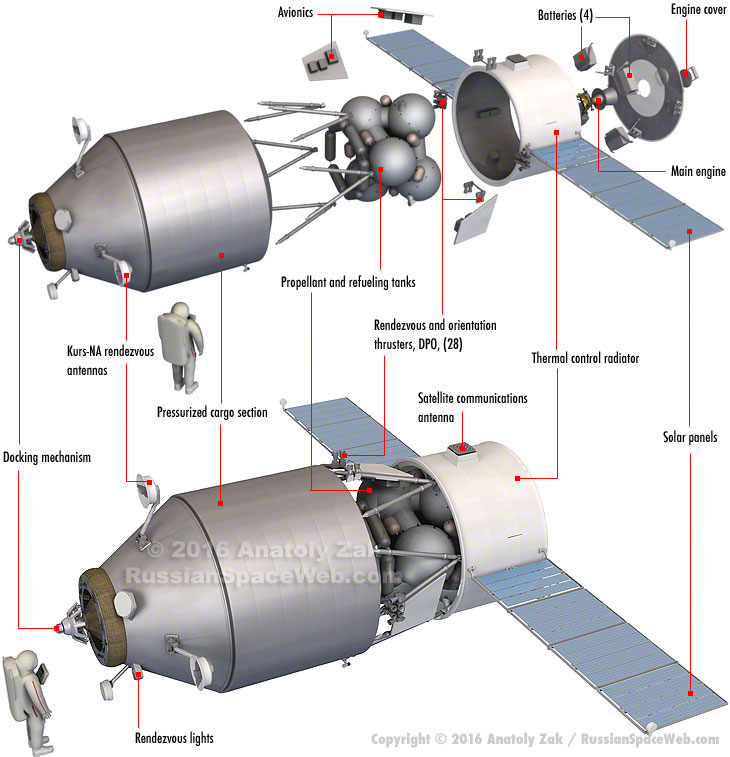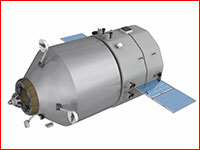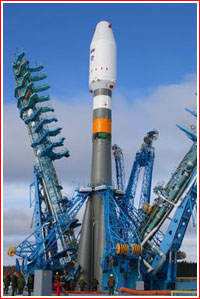Progress cargo ship replacement proposed (original) (raw)
New-generation cargo ship design is ready
In December 2016, RKK Energia completed the Experimental Project (Detailed Design) for a new cargo ship, which would take full advantage of the payload capacity of the Soyuz-2-1b rocket, delivering around 8.2 tons to the low Earth orbit or nearly a ton more than the mass of the Progress cargo ship series launched on previous versions of the Soyuz rockets.
Previous chapter: Progress cargo ship

The architecture of the prospective cargo ship as of August 2016.
From the publisher: Pace of our development depends primarily on the level of support from our readers!
Project history
On Dec. 11, 2015, Roskosmos awarded a contract to RKK Energia to develop a preliminary design of the spacecraft, which was characterized as "cargo vehicle with increased payload capacity," or TGK PG. This designation referred to the current capabilities of the Progress cargo ship, which has an overall mass of around seven tons. The same contract also assigned the company to upgrade the design documentation and operational manuals for the Soyuz MS and Progress MS spacecraft to extend their stay in orbit up to 370 days (from the current average of around six months). (67)
The main rationale for the development of the new cargo ship was the urgent need to reduce the number of cargo launches to the ISS from four to three annually, while still supporting three crew members on the Russian segment of the station.
The preliminary design for the new cargo ship was originally to be completed in December 2016, but the work was apparently sped up to be completed in August of the same year. Still, even if the go ahead for the full-scale development of the project was given immediately, the new cargo ship was not expected to fly before 2020. In the meantime, the Russian crew onboard the ISS could be reduced from three to two people beginning in March 2017 onward, with the exception of a time period in 2018, when Russian cosmonauts would have to conduct spacewalks to outfit the newly arrived MLM module.
On Sept. 5, 2016, RKK Energia published a press-release confirming the work on the new cargo ship, however the company's head, Vladimir Solntsev, was quoted as saying that the completion of the preliminary design was still scheduled for December of that year.
Industry sources confirmed that the Experimental Project for the TGK PG had been completed by the end of 2016, however a previously planned critical review of the project had to be put off until 2017.
Spacecraft design
Unlike many previous attempts to upgrade the Progress series, the latest proposal is essentially a new design, relying on engineering ideas recently developed for the Federatsiya next-generation transport ship, PTK, and its derivatives. Most significantly, a cluster of six tanks originally developed for the PTK's propulsion module was scaled down to serve as a combined tanker for the space station and the propellant storage for the new ship's own propulsion system.
The complex geometry making a pair of three interlocking tanks resembles Escher's mind-bending artwork, but it neatly packages liquid propellant in multiple spherical containers. The combined propellant section provides major advantage over the Progress design, built around separate refueling and propulsion modules.
Structurally, the new cargo ship would consist of a pressurized module carrying dry cargo and water and an unpressurized instrument module containing the propellant tanks. The cargo section of the new spacecraft would feature a central passageway and standard lockers, significantly simplifying loading and unloading of the ship.
A light-weight truss adapter would connect the two parts. The truss would also carry four groups of attitude control engines and three pallets with avionics. The pallets were designed to radiate excessive heat generated by electronics into space. Other electronic components, which were not designed to operate in vacuum, would be accommodated inside the pressurized section.
The new cargo ship was expected to carry a main engine developed at KB Khimmash for another spacecraft. Industry observers suggested that the main engine for the future cargo ship could have been originally developed for the cancelled Yenisei satellite. The engine is believed to feature a pressure-fed propellant supply system and is capable of producing 600 kilograms of thrust.
The attitude control thrusters for the new spacecraft would be borrowed unchanged from Soyuz and Progress transport ships.
The increased amount of deliverable propellant and the more powerful main engine will enable effective use of the spacecraft for correcting the orbit of the ISS and will provide the capability for deorbiting of the station at the end of its life span, RKK Energia said.
(To be continued)
Known specifications of the proposed replacement for the Progress cargo ship:
| Liftoff mass | up to 8,180 kilograms |
|---|---|
| Cargo mass deliverable to the space station, including: | up to 3,400 kilograms |
| - Dry cargo in the pressurized cargo compartment | up to 2,400 kilograms |
| - Propellant in storage section and for transfer to the space station | up to 1,840 kilograms |
| - Water (counts as part of dry cargo in the pressurized compartment) | up to 400 kilograms |
| - Gas for transfer into space station habitation volume | up to 55 kilograms |
| Nominal flight duration | up to 370 days |
| Autonomous flight duration | up to 30 days |
| Total volume of the pressurized cargo module | 18 cubic meters |
Read much more about the history of the Russian space program in a richly illustrated, large-format glossy edition:
The article, graphics and illustrations by Anatoly Zak; Last update:October 7, 2019
Page editor: Alain Chabot; Last edit: September 6, 2016
All rights reserved

An early concept of a cargo ship custom-built for the Soyuz-2-1b rocket. Copyright © 2016 Anatoly Zak
)
An artist rendering of a new-generation Russian cargo ship conducting a flyaround of the International Space Station, before initiating the final approach to the outpost. Click to enlarge. Copyright © 2016 Anatoly Zak

The new-generation cargo ship could begin flying on Soyuz-2-1b rocket as early as 2020, if the full-scale development would begin in 2016 or 2017. However, at the time, Roskosmos did not fund the work beyond the preliminary design. Credit: Roskosmos


